QN: Eternità d’artista, una Spoon River per Cattelan di Claudio Spadoni
“Forme nel verde », rassegna annuale d’arte contemporanea e più specificamente di scultura, è a un passo dal mezzo secolo. Anche se, a dire il vero, da tempo la storica manifestazione ideata da Mario Guidotti (1923/2011) e allestita nei cinquecenteschi Orti Leonini fra odorose siepi di bosso e vetusti lecci, denunciava una stanca senescenza. Ci voleva una nuova idea, e una ventata di giovinezza, per rilanciare la posta. Ed ecco, come estratto da un cilindro, il nome di Maurizio Cattelan, a suggerire l’opera collettiva che sotto la guida appassionata di Gaia Pasi hanno realizzato 200 allievi delle Accademie di Belle Arti di Firenze e di Carrara.
Segnali sparsi, appena individuabili ma un po’ allarmanti, immagini di topi che spuntano qua e là per le strade di San Quirico come interventi di ‘street poster art’, potano da un lato a una sezione di dipinti ospitata a Palazzo Chigi, dall’altro alla fauna imprecisabile fatta di ramaglie installata tra le siepi degli Horti Leonini. Ma è qui, sulla parte alta, che ci si trova di fronte a « Eternity », un cimitero di un centinaio di lapidi marmoree che potrebbe far pensare alla collina di Spoon River se buona parte dei nomi dei defunti, veri o presunti, non fosse di artisti da manuale e non dell’eterogenea, comune umanità evocata da Edgar Lee Masters.
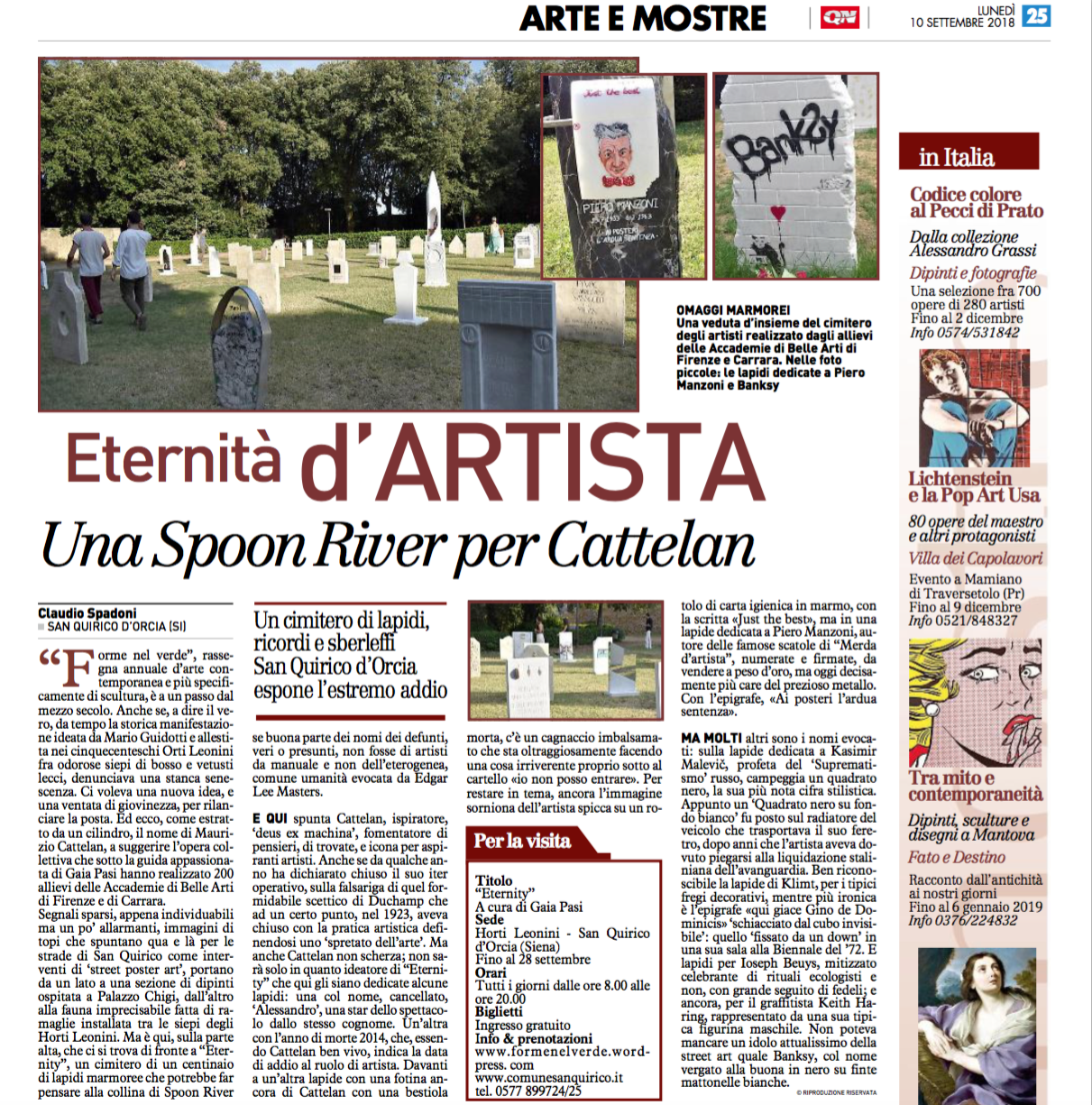
E qui spunta Cattelan, ispiratore, ‘deux ex machina’, fomentatore di pensieri, di trovate, e icona per aspiranti artisti. Anche se da qualche anno ha dichiarato chiuso il suo iter operativo, sulla falsariga di quel formidabile scettico di Duchamp che ad un certo punto, nel 1923, aveva chiuso con la pratica artistica definendosi uno ‘spretato dell’arte’. Ma anche Cattelan non scherza ; non sarà solo in quanto ideatore di « Eternity » che qui gli siano dedicate alcune lapidi : una col nome, cancellato, ‘Alessandro’, una star dello spettacolo dallo stesso cognome. Un’altra con l’anno di morte 2014, che, essendo Cattelan ben vivo, indica la data di addio al ruolo di artista. Davanti a un’altra lapide con una fotina ancora di Cattelan con una bestiola morta, c’è un cagnaccio imbalsamato che sta oltraggiosamente facendo una cosa irriverente proprio sotto al cartello «io non posso entrare». Per restare in tema, ancora l’immagine sorniona dell’artista spicca su un rotolo di carta igienica in marmo, con la scritta «Just the best», ma in una lapide dedicata a Piero Manzoni, autore delle famose scatole di « Merda d’artista », numerate e firmate, da vendere a peso d’oro, ma oggi decisamente più care del prezioso metallo. Con l’epigrafe, «Ai posteri l’ardua sentenza ».
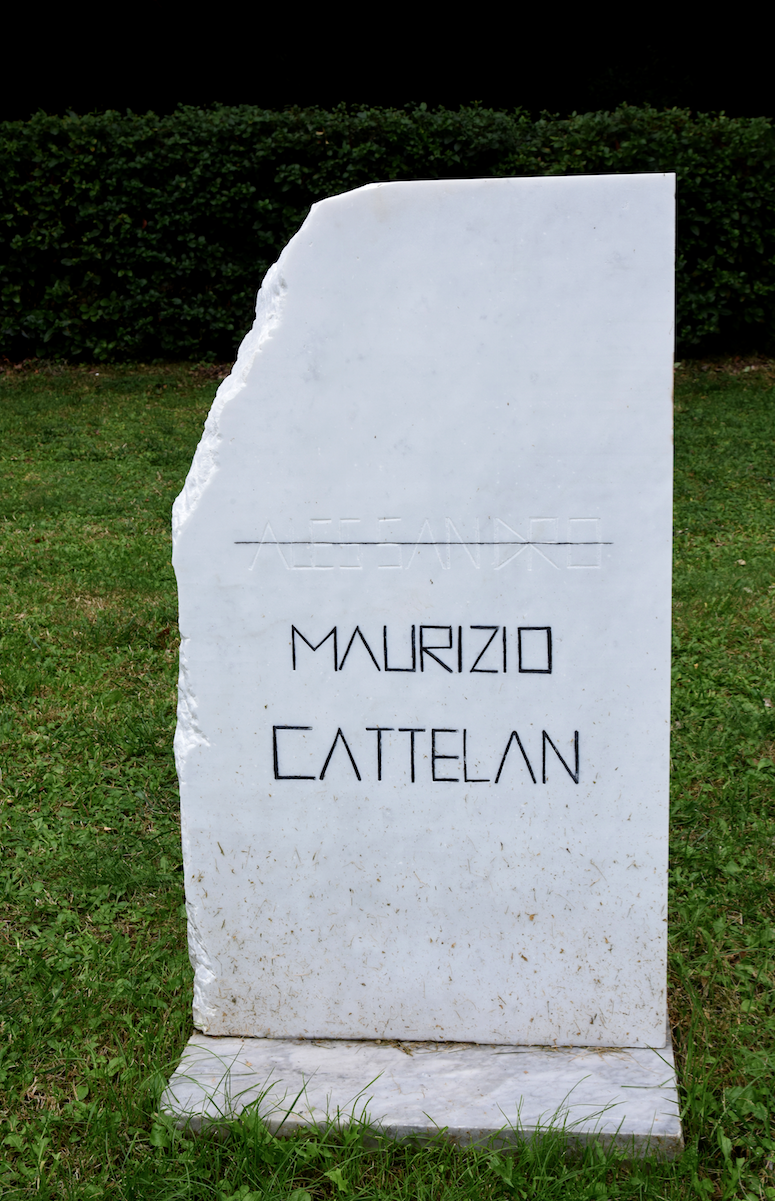
Bianca Busoni, Lapide di Maurizio Cattelan, (2018)
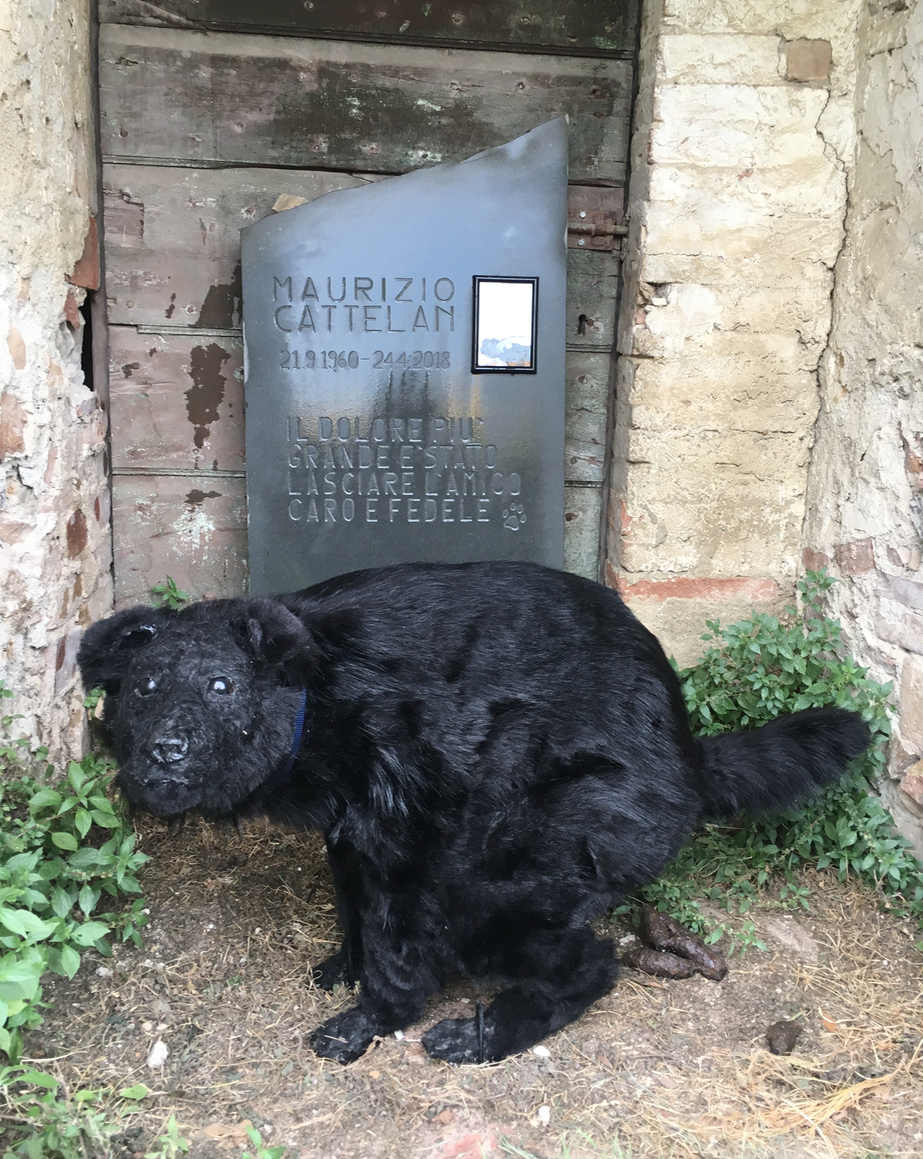
Filippo Gallorini, Lapide all’amicizia, (2o18)

Davide Vanzo “Lapide Piero Manzoni” (2018)
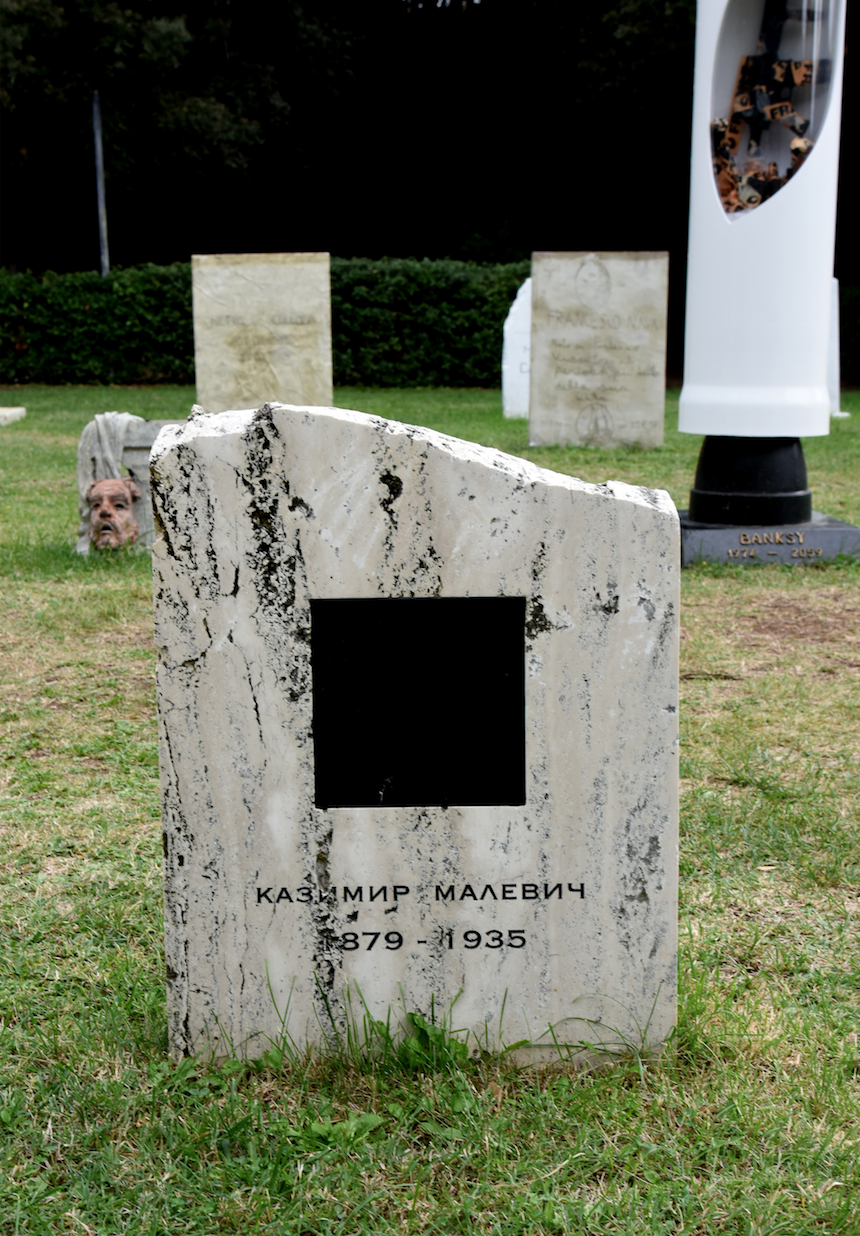
Daniele Di Mauro “Lapide di Malevic” (2018)
Ma molti altri sono i nomi evocati: sulla lapide dedicata a Kasimir Malevič, profeta del ‘Suprematismo’ russo, campeggia un quadrato nero, la sua più nota cifra stilistica. Appunto un ‘Quadrato nero su fondo bianco’ fu posto sul radiatore del veicolo che trasportava il suo feretro, dopo anni che l’artista aveva dovuto piegarsi alla liquidazione staliniana dell’avanguardia. Ben riconoscibile la lapide di Klimt, per i tipici fregi decorativi, mentre più ironica è l’epigrafe «qui giace Gino de Dominicis» ‘schiacciato dal cubo invisibile’: quello ‘fissato da un down’ in una sua sala alla Biennale del ’72. E lapidi per Ioseph Beuys, mitizzato celebrante di rituali ecologisti e non, con grande seguito di fedeli; e ancora, per il graffitista Keith Haring, rappresentato da una sua tipica figurina maschile. Non poteva mancare un idolo attualissimo della street art quale Banksy, col nome vergato alla buona in nero su finte mattonelle bianche.
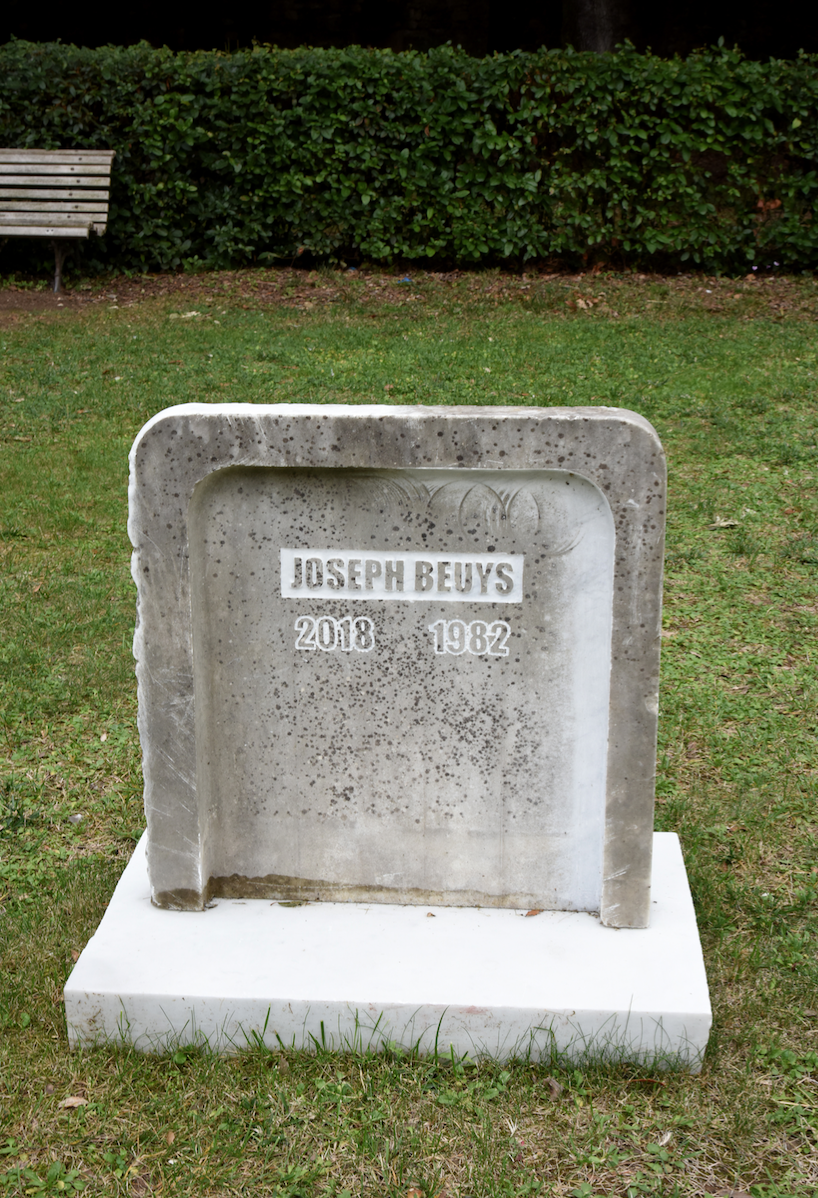
Domenico Festa, “Lapide di Joseph Beuys” (2018)
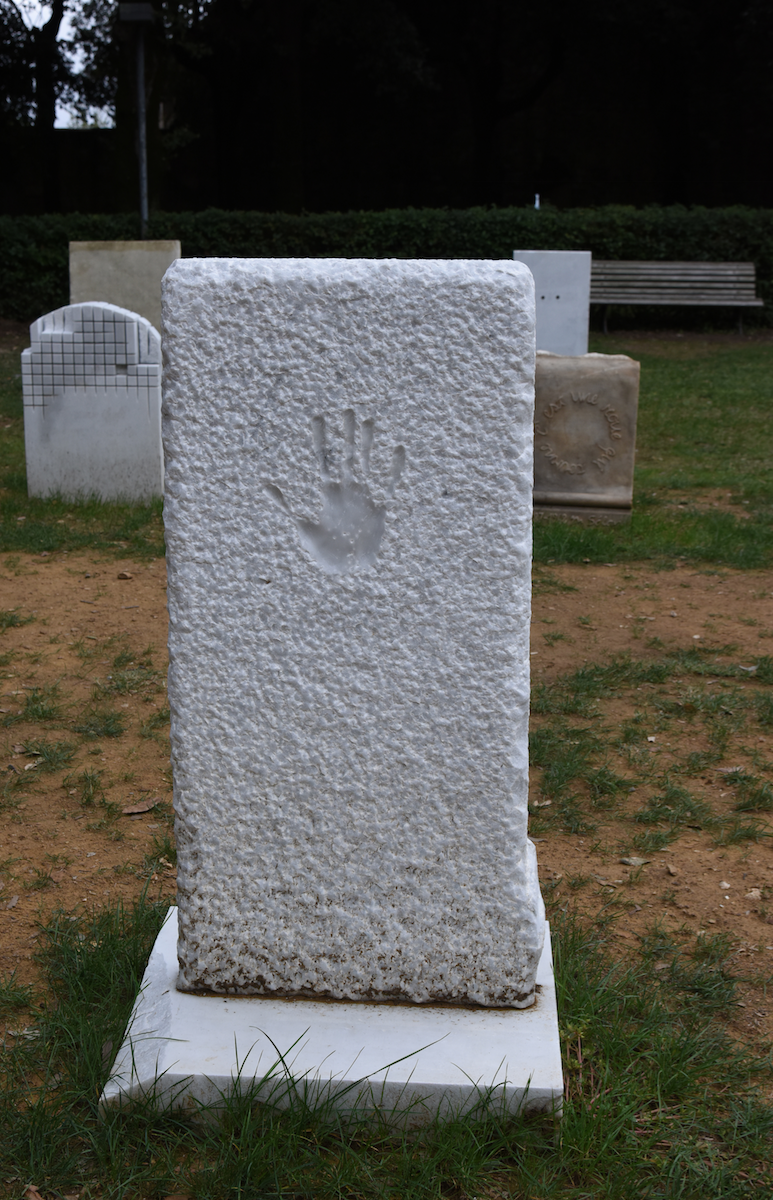
Alfredo Calasso “Lapide di Alfredo Calasso” (2018)
Claudio Spadoni
[“Forme nel verde”, an annual exhibition of contemporary art ,and specifically, of sculptures, is a step away from its half century anniversary. Even if, truth be told, for a long time the historical event conceived by Mario Guidotti and set up in the sixteenth-century Horti Leonini between fragrant boxwood hedges and ancient holm oaks, submitted itself to a senescence. It took on a new idea, a breath of fresh air, to revive itself. And here, as if taken from a cylinder, is Maurizio Cattelan, suggesting a collective work that under the passionate guidance of Gaia Pasi has been created by 200 students of the Florentine and Carraran Academies of Fine Arts.
Scattered signs, barely detectable and little alarming, images of mice that appear here and there in the streets of San Quirico as ‘street poster art’ interventions, can allude on one hand to a section of paintings housed in Palazzo Chigi, on the other hand to the fauna made of branches installed between the hedges of the Horti Leonini. But it is here, at the top, that you find yourself in front of “Eternity”, a cemetery of a hundred marble tombstones that could make you think of the hill of Spoon River if most of the names of the deceased, true or presumed, were not by textbook artists and not by the heterogeneous, common humanity evoked by Edgar Lee Masters.

And here comes Cattelan, inspirer, ‘




Many other names are evoked: on a tomb dedicated to Kasimir Malevič, prophet of Russian ‘Suprematism’, stands a black square, his most famous stylistic feature. Indeed, a ‘Black square on a white background’ was placed on the radiator of the vehicle carrying his coffin, after years of having the artist bending to the Stalinist liquidation of the avant-garde. Klimt’s tombstone is clearly recognisable, with its typical decorative friezes, while the”qui giace Gino de Dominicis” (crushed by the invisible cube) epigraph alludes to the ironic: the one ‘fixed by a down’ in one of his rooms at the 1972 Biennial. Joseph Beuys’ gravestone is a mythical celebrant of ecological and non-ecological rituals, with a large following of believers; and finally, one for the graffiti artist Keith Haring, represented by his typical male figure. The very contemporary icon of street art, Banksy, with his name inscribed with black spray paint on fake white tiles could not be missing from the show.


